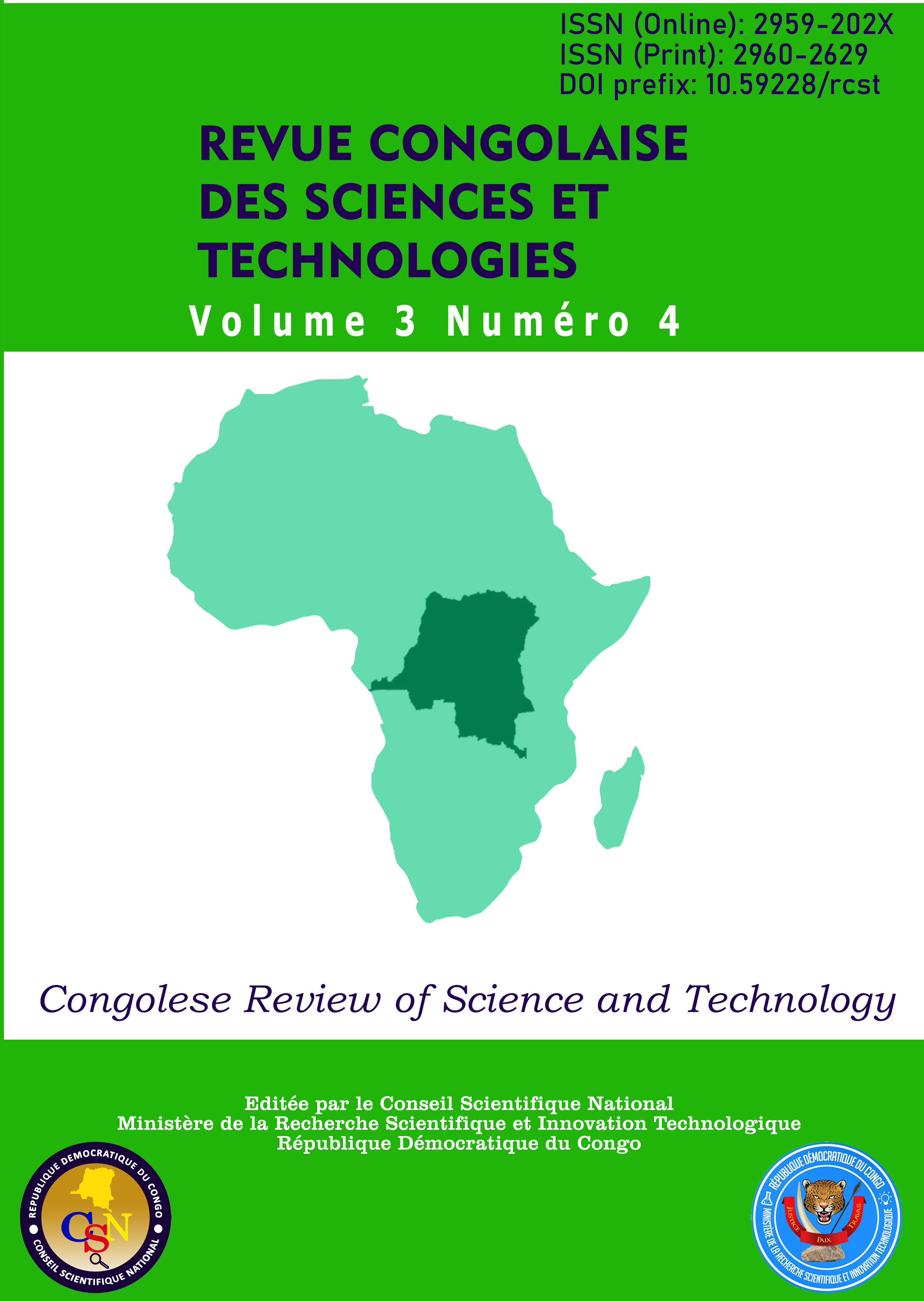Avifaune du domaine et réserve de chasse de Bombo Lumene, Kinshasa, République Démocratique du Congo : Diversité et distribution dans différents habitats
Contenu principal de l'article
Résumé
Bien que le réseau de réserves de la République Démocratique du Congo abrite l'assemblage d'oiseaux le plus diversifié de la région afrotropicale, les études ornithologiques y sont particulièrement rares. Dans cet article, nous fournissons le premier inventaire détaillé des espèces d'oiseaux de Bombo-Lumene et de leur distribution dans différents habitats, basé sur la collecte de spécimens au filet japonais dans trois habitats différents, réalisée entre février et décembre 2023. Nous avons récolté un total de 113 espèces, réparties dans 34 familles et 5 ordres, y compris Cossypha heinrichi, une espèce menacée. Comme ailleurs, les Passeriformes sont les plus représentés avec plus de 80 espèces et 20 familles. Nous avons constaté que les habitats de savane et de forêt abritent les communautés d'espèces les plus diversifiées, tandis que les habitats transformés par l'homme, tels que les fourrés, abritent les communautés les moins diversifiées. Dans l'ensemble, les indices écologiques basés sur l'abondance des espèces suggèrent que les habitats évalués à Bombo-Lumene sont en bonne santé écologique. Nos résultats confirment le statut de Zone Importante pour la Conservation des Oiseaux (ZICO) de l’aire protégée de Bombo-Lumène en Afrique. Les conflits ethniques, la demande croissante de terres utilisées pour l'agriculture et les installations humaines, et le braconnage sont les principales menaces locales pour la diversité biologique de Bombo-Lumène en général et pour la diversité de ses oiseaux en particulier. D'autres enquêtes et études dans la réserve, couvrant tous les types d'habitats et une surface étendue de la réserve, sont fortement recommandées pour mieux saisir la composition des espèces d'oiseaux et m0ettre à jour les stratégies et les politiques pour la conservation de ces communautés extrêmement diversifiées.
Details de l'article
Rubrique

Ce travail est disponible sous licence Creative Commons Attribution - Pas d’Utilisation Commerciale - Partage dans les Mêmes Conditions 4.0 International.
Références
Akogwu, S.A., Ihuma, J.O., & Manu, S. (2012). Survey of abundance and diversity of avian species in Assop Forest Reserve and surrounding farmlands in Jos, Nigeria. International Journal of Advanced Biological Research, 2 (3), 506–514.
Bell, T., Newman, J.A., Silverman, B.W., Turner, S.L., & Lilley, A.K. (2005). The Contribution of species richness and composition to bacterial services. Nature, 436, 1157–1160. https://doi.org/10.1038/nature03891
Burel, F. & Baudry, J. (1999). Ecologie du paysage. Concepts, méthodes et applications. Paris: Technique & Documentation, pp. 359.
Cooper, J.E. (1995). The role of birds in sustainable food production. Biodiversity and Conservation, 4, 266–280. https://doi.org/10.1007/BF00055973
Daly, A.J., Baetens, J.M., & De Baets, B. (2018). Ecological diversity: measuring the unmeasurable. Mathematics, 6 (7), 119. https://doi.org/10.3390/math6070119
Demey, R. & Louette, M. (2001). Democratic Republic of Congo. In: Fishpool, L.D.C., & Evans, M.I. (eds.), Important Bird Areas in Africa and associated islands: priority sites for conservation. Newbury and Cambridge, UK: Pisces Publications and BirdLife International, pp. 199–218.
Derebe, Y., Derebe, B., Kassaye, M., & Gibru, A. (2023). Species diversity, relative abundance, and distribution of avifauna in different habitats within Lewi Mountain, Awi zone, Ethiopia. Heliyon, 9 (6), e17127. https://doi.org/10.1016/j.heliyon.2023.e17127
Desalegn, T., Aynalem, S., & Tassie, N. (2020). Diversity, abundance and habitat association of avifauna in Menagesha Amba Mariam and Gara Medhanialem forest , in Oromia Region, Ethiopia. International Journal of Avian & Wildlife Biology, 5 (1), 61–70. https://doi.org/10.15406/ijawb.2020.05.00175
Esayas, K., & Bekele, A. (2011). Species composition, relative abundance and distribution of the avian fauna of Entoto Natural Park and escarpment, Addis Ababa. Ethiop. J. Sci, 34 (2), 113–122.
Frie, A.C. (2018). Insignia of power: bird imagery on artefacts of hierarchy and ritual in Iron Age Dolenjska (SE Slovenia). Documenta Praehistorica, 45, 166–178. https://doi.org/10.4312/dp.45.13
Fry, C.H. (2004). Malimbus. In Fry, C.H., & Keith, S. (eds.). The birds of Africa, vol. VII: sparrows to buntings. London: Christopher Helm, pp. 77–97.
Fry, H.C., Keith, S., & Urban, E.K. (2004). The birds of Africa. Vols. I–VII. London: Academic Press and Christopher Helm, pp. 1982–2004.
Fry, H.C., Keith, S., Lack, P.C., de Naurois, R., Prigogine, A., & Urban, E.K. (1997). Turdidae, thrushes. In Urban, E.K., Fry, C.H., & Keith, S. (eds.). The birds of Africa, vol. V: thrushes to puffback flycatchers. London: Academic Press, pp. 1–56.
Gill, F., & Donsker, D. (2013). The Birds of Democratic Republic of Congo. IOC World Bird List. (ed.), Version 4.3. Accessed November 04, 2014. http://www.the-birds.net/aves/republique.democratique.du.congo.html.
Habiyaremye, M.F., Nlandu, L., & Malio, N. (2011). Habitats de la Réserve et Domaine de chasse de Bombo-Lumene (R.D.C). Lexique Kiteke des plantes observées dans ces milieux. Institut Congolais pour la Conservaion de la Nature, 144p.
Ifuta, N.B., Kenawabo, T., Mampembe, L., Zambi, T., Palata, K., & Punga, K. (2002). Avian fauna of green species of Kinshasa and surroundings. Les Cahiers de l’ISP, 11, 19–30.
Inogwabini, B.I., Ilambu, O., & Gbanzi, M.A. (2005). Protected areas of the Democratic Republic of Congo. Conservation Biology, 19 (1), 15–22. https://doi.org/10.1111/j.1523-1739.2005.00181.x
Jones, S., & Jamie, G. (2023). Avifauna. In Jocque, M., Mertens, J., Jamie, G., Jones, S., Mbende, M., Mpongo Iyomi, D.M., Nunes, M., Pett, B., Hamer, M., de Haas, M., Van Roie, M., & Van Noppen, M. (2023). The Salonga National Park expedition: a rapid biodiversity assessment in the largest forest reserve in Africa, DRC. Glabbeek, Belgium: Biodiversity Inventory for Conservation, pp. 131. https://doi.org/10.1007/978-981-13-2538-0_2128
King, T., & Chamberlan, C. (2013). Where does the savannah fauna of the Bateke Plateau come from? Wild Conservation, 1, 10–16.
Kisasa, K.R., & Aloni, K.J. (2011). The impact of soil texture on the selection of nesting sites by the Malachite Kingfisher (Alcedinidae: Alcedo cristata Pallas 1764). Ostrich, 82 (3), 243–246. https://doi.org/10.2989/00306525.2011.616696
Kisasa, K.R. (2012). Diet of the Malachite Kingfisher Alcedo cristata during the breeding period in the Kinshasa area (Democratic Republic of Congo). Malimbus journal, 34, 17–28.
Kisasa, K.R., Bansomire, C., Ngandu, L.M., & Malekani, D.V. (2020). Ectoparasites (Phthiraptera) de quelques oiseaux de la ville de Kinshasa. Malimbus, 42 (1), 1–6. http://www.malimbus.org/en/contents/tocm42.html
Kisasa, K.R., & Punga, K.J. (2024). The relative influence of habitat modification on bird assemblage in the University’s domain of Notre Dame du Kasai in Kananga, D. R. Congo. Revue Congolaise de Sciences et technologies, 3 (1), 16–23. https://doi.org/10.59228/rcst.024.v3.i1.63
Laurence, D. (2006). Sélection de l’habitat par les oiseaux forestiers et modernisation de leur distribution potentielle en chênaie et hêtraie ardennaises : impact de la composition et de la structure forestière. Thèse de Doctorat, Gembloux, Faculté universitaire des Sciences agronomiques, 253 p.
Lepage, D. (2024a). Checklist of the birds of Kinshasa city. Avibase, the world bird database. Retrieved on May 31st, 2024, from. https://avibase.bsc-eoc.org
Lepage, D. (2024b). Checklist of the birds of Democratic Republic of Congo. Avibase, the world bird database. Retrieved on May 31st, 2024, from https://avibase.bsc-eoc.org.
Lê S., Josse, J., & Husson, F. (2008). FactoMineR: an R package for multivariate analysis. Journal of Statistical Software, 25 (1), 1–18. https://doi.org/10.18637/jss.v025.i01
Liyandja, T.L.D., Andersen, M.J., Oliveros, C.H., Kalemba, L.N., Bakambana, T.L., Marks, B.D., Kahindo, C., & Malekani, J.M. (2015). Birds of the man and biosphere reserve of Luki, Bas-Congo province, Democratic Republic of Congo. Check List, 11 (5), 1–15. https://doi.org/10.15560/11.5.1755
Louette, M., & Hasson, M. (2011). Les oiseaux du Katanga: studies in Afrotropical zoology. Tervuren: Royal Museum of Central Africa, p. 406.
Maznikova, V.N., Ormerod, S.J., & Gómez-Serrano, M.Á. (2024). Birds as bioindicators of river pollution and beyond: specific and general lessons from an apex predator. Ecological Indicators, 158, 111366. https://doi.org/10.1016/j.ecolind.2023.111366
Murhabale, B.C., Bwanamudogo, I., Magadju, A., Tolbert, S., Bapeamoni, F., Kahindo, C., Marks, B.D., & Agenong’a, U. (2021). Birds of Burhinyi mountain forest, north of Itombwe nature reserve, Democratic Republic of Congo. African Journal of Ecology, 59 (1), 305–311. https://doi.org/10.1111/aje.12825
Nsokimieno, E.M.M., Shouyu, C., & Li Qin, Z. (2010). Sustainable urbanization’s challenge in Democratic Republic of Congo. Journal of Sustainable Development, 3 (2), 242–254. https://doi.org/10.5539/jsd.v3n2p242
Nsombo, B.M., Lumbuenamo, R.S., Lejoly, J., Aloni, J.K., & Mafuka, P.M.M. (2016). Caractéristiques des sols sous savane et sous forêt naturelle sur le plateau des Batéké en République Démocratique du Congo. Tropicultura, 34 (1), 87–97.
N'Zala, D., Nongamani, A., & Moutsamboté, J.M. (1977). Diversité floristique dans les monocultures d’eucalyptus et de pins au Congo. Cahier Agricultures, 6, 169–174.
Peel, M.C., Finlayson, B.L., & McMahon, T.A. (2007). Updated world map of the Koppen-Geiger climate classification. Hydrology Earth System Sciences, 11 (5), 1633–1644. https://doi.org/10.1002/ppp.421
Punga, K.J., & Ifuta, S.N.B. (2015). Recent data on birds of Kinshasa in Democratic Republic of Congo. Journal of Agricultural Science and Technology A, 5, 218–233. https://doi.org/10.17265/2161-6256/2015.03.011
R Core Team (2013). R: A language and environment for statistical computing. Vienna, Austria.: R Foundation for Statistical Computing. Retrieved from. http://www.r-project.org/
Rodríguez-Estrella, R. (2007). Land use changes affect distributional patterns of desert birds in the Baja California peninsula, Mexico. Diversity and Distributions, 13 (6), 877–889. https://doi.org/10.1111/j.1472-4642.2007.00387.x
Sinclair, I., & Ryan, P. (2010). Birds of Africa south of the Sahara. Cape Town: Struik Nature, 767p. ISBN 1770076239, 9781770076235
Tietze, D.T. (2019). Bird species: how they arise, modify and Vanish. Basel, Switzerland: Springer Open, p. 266. https://doi.org/10.2307/j.ctvpb3vwx.12
Tshisuku, M.J.V., Musibono, E.D., Lubini, A.C., & Ifuta, N.B.S. (2021). Preliminary study of the avifauna of the families Numididae and Phasianidae (Galliformes) of the Bombo-Lumene hunting area and reserve in Kinshasa (DR Congo). World Journal of Advanced Research and Reviews, 12 (2), 019–031. https://doi.org/10.30574/wjarr.2021.12.2.0529
Vermeulen, C., & Lanata, F. (2006). Le domaine de chasse de Bombo-Lumene: un espace naturel en péril aux frontières de Kinshasa. Parcs et Reserves, 61 (2), 4–8.
Voelker, G., Marks, B.D., Kahindo, C., Agenong'a, U., Bapeamoni, F., Duffie, L.E., Huntley, J.W., Mulotwa, E., Rosenbaum, S.A., & Light, J.E. (2013). River barriers and cryptic biodiversity in an evolutionary museum. Ecology and Evolution, 3 (3), 536–545.
Yabi, B.F, Olou, L.T., & Codjia, T-C. (2017). Influence des zones biogéographiques sur la diversité avienne des galéries forestières au Bénin, afrique de l’Ouest. European Scientific Journal, 13 (6), 410–438.

